The Significance of Money in Employee Engagement Strategies
VerifiedAdded on 2020/01/23
|7
|1445
|84
Essay
AI Summary
This essay examines the pivotal role of financial incentives in driving employee engagement and workplace satisfaction. It argues that money is a key motivator, influencing employee performance and loyalty. The essay delves into the application of McClelland's and Herzberg's motivational theories, illustrating how financial rewards, recognition, and the fulfillment of needs for achievement, power, and affiliation can significantly enhance employee commitment. It also explores the impact of hygiene and motivational factors, as defined by Herzberg, on employee retention and overall organizational efficiency. The essay emphasizes the importance of a supportive work environment, credible leadership, and strong communication channels alongside monetary incentives to foster a high-performing and profitable workplace. It concludes that in the competitive global economy, integrating monetary strategies with other engagement techniques is essential for organizational success.

Money Is the Key to
Employee Engagement
Employee Engagement
Paraphrase This Document
Need a fresh take? Get an instant paraphrase of this document with our AI Paraphraser
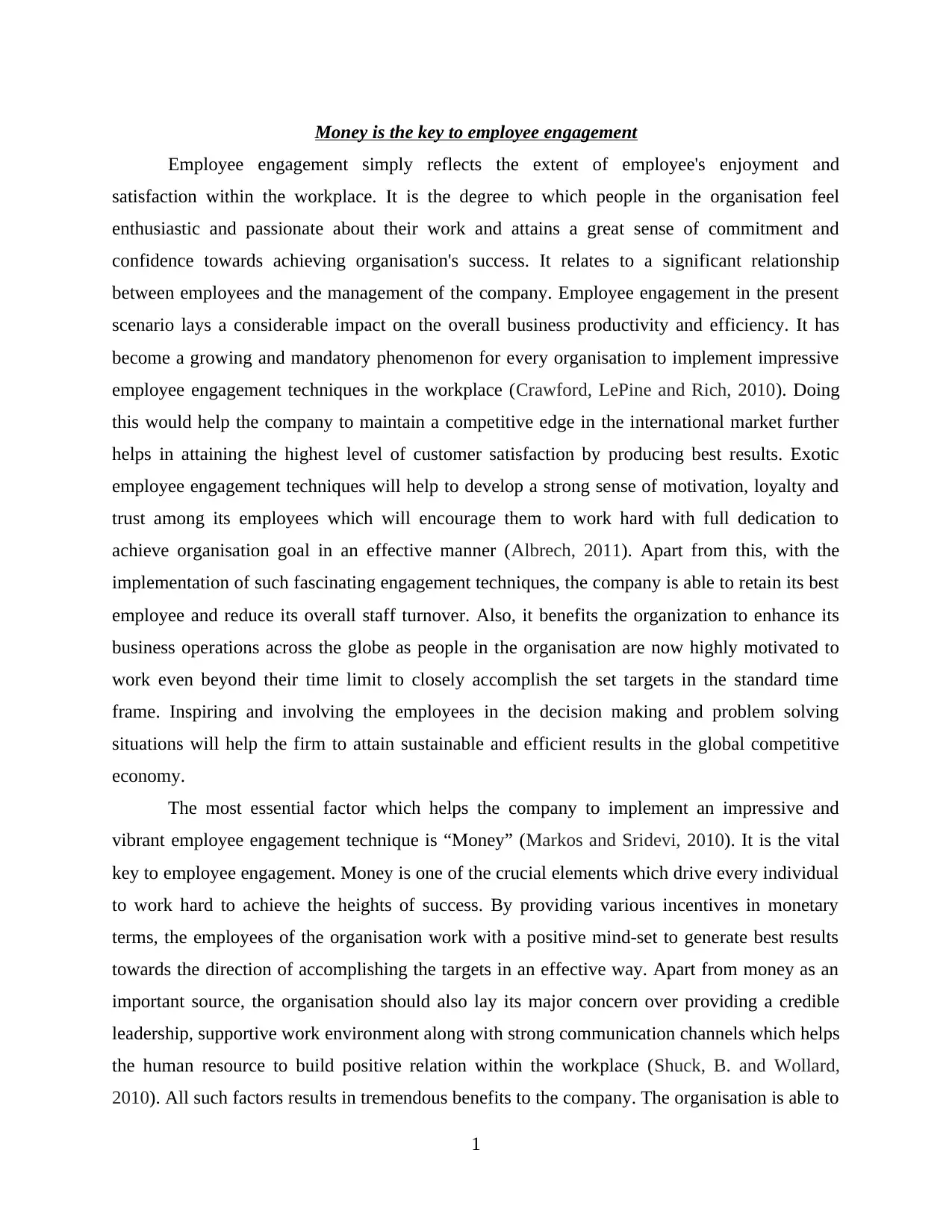
Money is the key to employee engagement
Employee engagement simply reflects the extent of employee's enjoyment and
satisfaction within the workplace. It is the degree to which people in the organisation feel
enthusiastic and passionate about their work and attains a great sense of commitment and
confidence towards achieving organisation's success. It relates to a significant relationship
between employees and the management of the company. Employee engagement in the present
scenario lays a considerable impact on the overall business productivity and efficiency. It has
become a growing and mandatory phenomenon for every organisation to implement impressive
employee engagement techniques in the workplace (Crawford, LePine and Rich, 2010). Doing
this would help the company to maintain a competitive edge in the international market further
helps in attaining the highest level of customer satisfaction by producing best results. Exotic
employee engagement techniques will help to develop a strong sense of motivation, loyalty and
trust among its employees which will encourage them to work hard with full dedication to
achieve organisation goal in an effective manner (Albrech, 2011). Apart from this, with the
implementation of such fascinating engagement techniques, the company is able to retain its best
employee and reduce its overall staff turnover. Also, it benefits the organization to enhance its
business operations across the globe as people in the organisation are now highly motivated to
work even beyond their time limit to closely accomplish the set targets in the standard time
frame. Inspiring and involving the employees in the decision making and problem solving
situations will help the firm to attain sustainable and efficient results in the global competitive
economy.
The most essential factor which helps the company to implement an impressive and
vibrant employee engagement technique is “Money” (Markos and Sridevi, 2010). It is the vital
key to employee engagement. Money is one of the crucial elements which drive every individual
to work hard to achieve the heights of success. By providing various incentives in monetary
terms, the employees of the organisation work with a positive mind-set to generate best results
towards the direction of accomplishing the targets in an effective way. Apart from money as an
important source, the organisation should also lay its major concern over providing a credible
leadership, supportive work environment along with strong communication channels which helps
the human resource to build positive relation within the workplace (Shuck, B. and Wollard,
2010). All such factors results in tremendous benefits to the company. The organisation is able to
1
Employee engagement simply reflects the extent of employee's enjoyment and
satisfaction within the workplace. It is the degree to which people in the organisation feel
enthusiastic and passionate about their work and attains a great sense of commitment and
confidence towards achieving organisation's success. It relates to a significant relationship
between employees and the management of the company. Employee engagement in the present
scenario lays a considerable impact on the overall business productivity and efficiency. It has
become a growing and mandatory phenomenon for every organisation to implement impressive
employee engagement techniques in the workplace (Crawford, LePine and Rich, 2010). Doing
this would help the company to maintain a competitive edge in the international market further
helps in attaining the highest level of customer satisfaction by producing best results. Exotic
employee engagement techniques will help to develop a strong sense of motivation, loyalty and
trust among its employees which will encourage them to work hard with full dedication to
achieve organisation goal in an effective manner (Albrech, 2011). Apart from this, with the
implementation of such fascinating engagement techniques, the company is able to retain its best
employee and reduce its overall staff turnover. Also, it benefits the organization to enhance its
business operations across the globe as people in the organisation are now highly motivated to
work even beyond their time limit to closely accomplish the set targets in the standard time
frame. Inspiring and involving the employees in the decision making and problem solving
situations will help the firm to attain sustainable and efficient results in the global competitive
economy.
The most essential factor which helps the company to implement an impressive and
vibrant employee engagement technique is “Money” (Markos and Sridevi, 2010). It is the vital
key to employee engagement. Money is one of the crucial elements which drive every individual
to work hard to achieve the heights of success. By providing various incentives in monetary
terms, the employees of the organisation work with a positive mind-set to generate best results
towards the direction of accomplishing the targets in an effective way. Apart from money as an
important source, the organisation should also lay its major concern over providing a credible
leadership, supportive work environment along with strong communication channels which helps
the human resource to build positive relation within the workplace (Shuck, B. and Wollard,
2010). All such factors results in tremendous benefits to the company. The organisation is able to
1
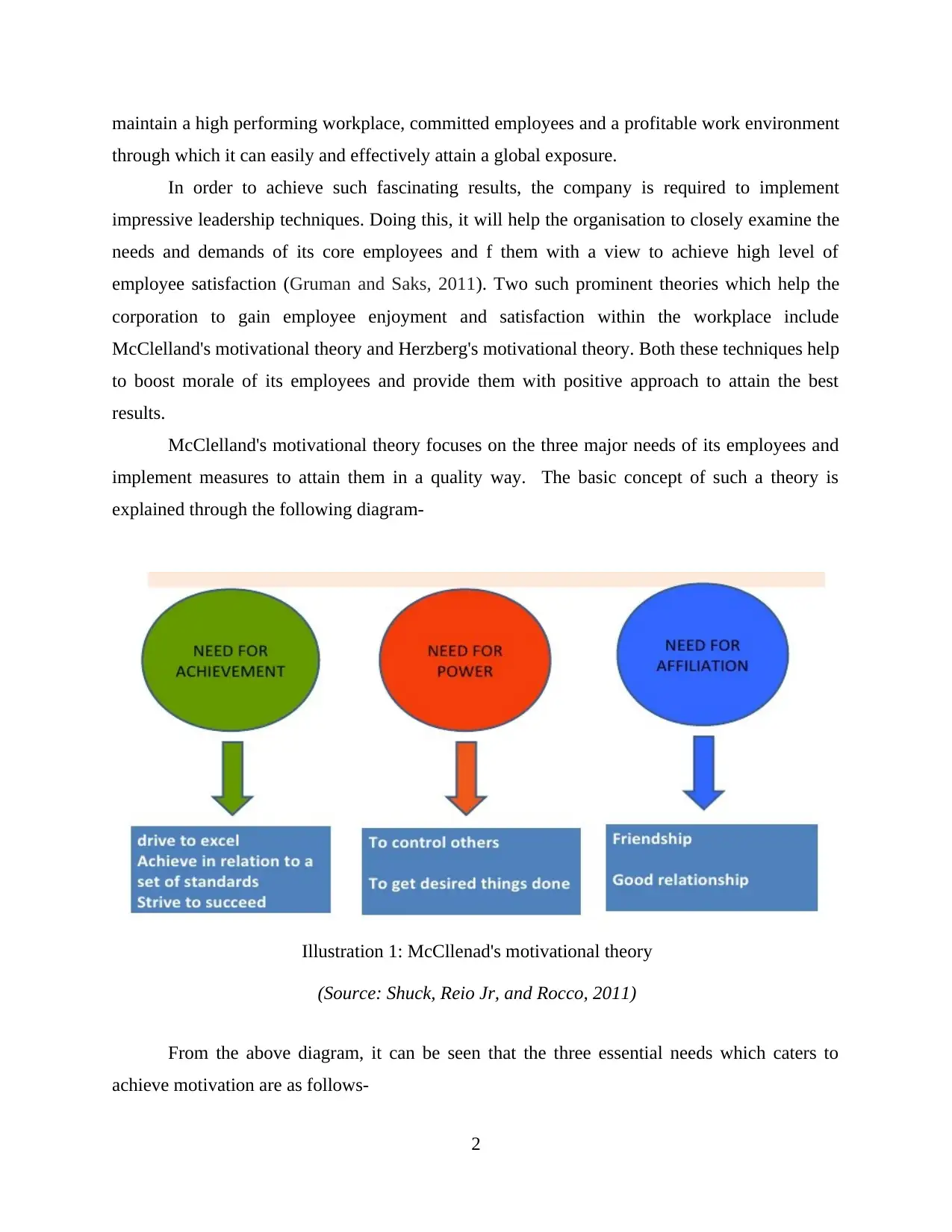
maintain a high performing workplace, committed employees and a profitable work environment
through which it can easily and effectively attain a global exposure.
In order to achieve such fascinating results, the company is required to implement
impressive leadership techniques. Doing this, it will help the organisation to closely examine the
needs and demands of its core employees and f them with a view to achieve high level of
employee satisfaction (Gruman and Saks, 2011). Two such prominent theories which help the
corporation to gain employee enjoyment and satisfaction within the workplace include
McClelland's motivational theory and Herzberg's motivational theory. Both these techniques help
to boost morale of its employees and provide them with positive approach to attain the best
results.
McClelland's motivational theory focuses on the three major needs of its employees and
implement measures to attain them in a quality way. The basic concept of such a theory is
explained through the following diagram-
Illustration 1: McCllenad's motivational theory
(Source: Shuck, Reio Jr, and Rocco, 2011)
From the above diagram, it can be seen that the three essential needs which caters to
achieve motivation are as follows-
2
through which it can easily and effectively attain a global exposure.
In order to achieve such fascinating results, the company is required to implement
impressive leadership techniques. Doing this, it will help the organisation to closely examine the
needs and demands of its core employees and f them with a view to achieve high level of
employee satisfaction (Gruman and Saks, 2011). Two such prominent theories which help the
corporation to gain employee enjoyment and satisfaction within the workplace include
McClelland's motivational theory and Herzberg's motivational theory. Both these techniques help
to boost morale of its employees and provide them with positive approach to attain the best
results.
McClelland's motivational theory focuses on the three major needs of its employees and
implement measures to attain them in a quality way. The basic concept of such a theory is
explained through the following diagram-
Illustration 1: McCllenad's motivational theory
(Source: Shuck, Reio Jr, and Rocco, 2011)
From the above diagram, it can be seen that the three essential needs which caters to
achieve motivation are as follows-
2
⊘ This is a preview!⊘
Do you want full access?
Subscribe today to unlock all pages.

Trusted by 1+ million students worldwide
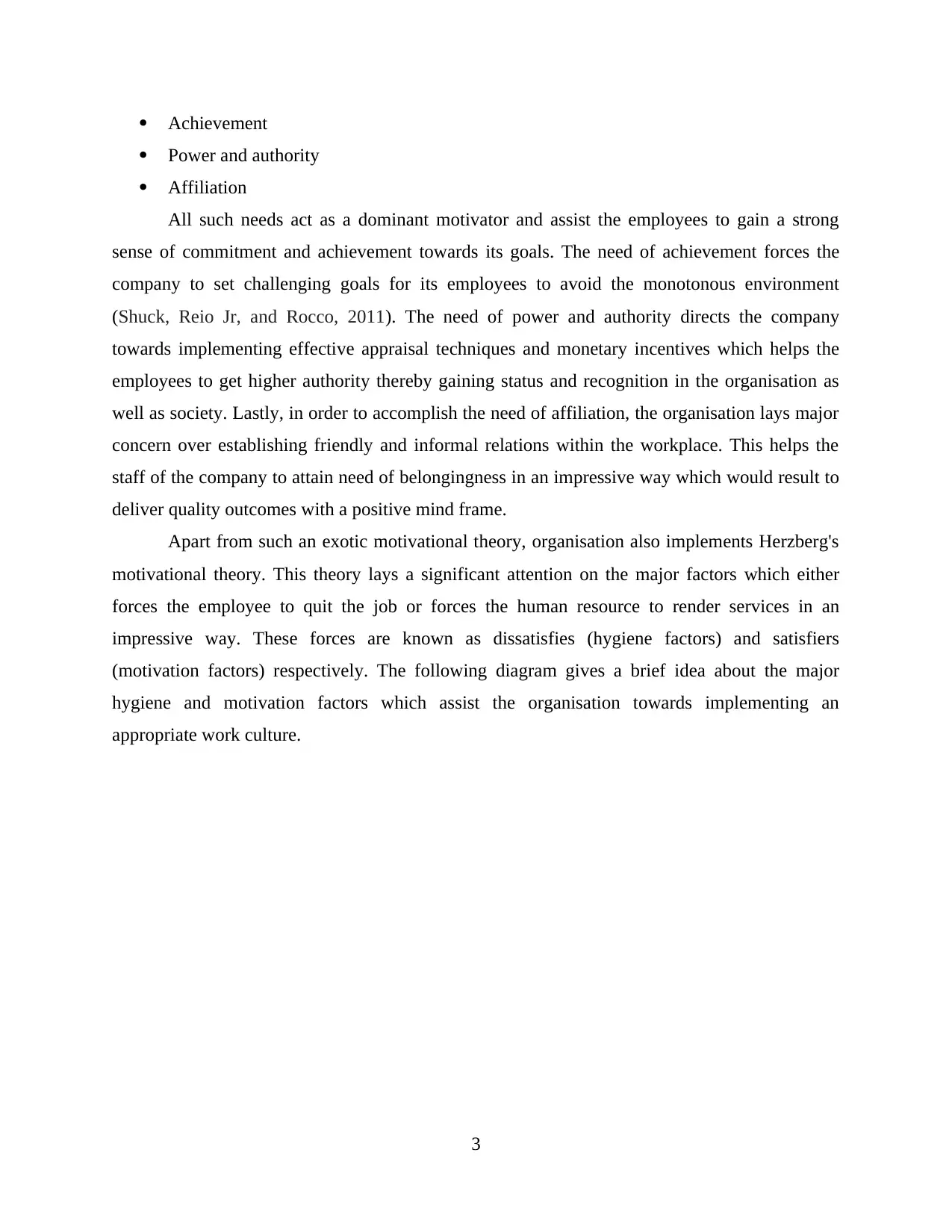
Achievement
Power and authority
Affiliation
All such needs act as a dominant motivator and assist the employees to gain a strong
sense of commitment and achievement towards its goals. The need of achievement forces the
company to set challenging goals for its employees to avoid the monotonous environment
(Shuck, Reio Jr, and Rocco, 2011). The need of power and authority directs the company
towards implementing effective appraisal techniques and monetary incentives which helps the
employees to get higher authority thereby gaining status and recognition in the organisation as
well as society. Lastly, in order to accomplish the need of affiliation, the organisation lays major
concern over establishing friendly and informal relations within the workplace. This helps the
staff of the company to attain need of belongingness in an impressive way which would result to
deliver quality outcomes with a positive mind frame.
Apart from such an exotic motivational theory, organisation also implements Herzberg's
motivational theory. This theory lays a significant attention on the major factors which either
forces the employee to quit the job or forces the human resource to render services in an
impressive way. These forces are known as dissatisfies (hygiene factors) and satisfiers
(motivation factors) respectively. The following diagram gives a brief idea about the major
hygiene and motivation factors which assist the organisation towards implementing an
appropriate work culture.
3
Power and authority
Affiliation
All such needs act as a dominant motivator and assist the employees to gain a strong
sense of commitment and achievement towards its goals. The need of achievement forces the
company to set challenging goals for its employees to avoid the monotonous environment
(Shuck, Reio Jr, and Rocco, 2011). The need of power and authority directs the company
towards implementing effective appraisal techniques and monetary incentives which helps the
employees to get higher authority thereby gaining status and recognition in the organisation as
well as society. Lastly, in order to accomplish the need of affiliation, the organisation lays major
concern over establishing friendly and informal relations within the workplace. This helps the
staff of the company to attain need of belongingness in an impressive way which would result to
deliver quality outcomes with a positive mind frame.
Apart from such an exotic motivational theory, organisation also implements Herzberg's
motivational theory. This theory lays a significant attention on the major factors which either
forces the employee to quit the job or forces the human resource to render services in an
impressive way. These forces are known as dissatisfies (hygiene factors) and satisfiers
(motivation factors) respectively. The following diagram gives a brief idea about the major
hygiene and motivation factors which assist the organisation towards implementing an
appropriate work culture.
3
Paraphrase This Document
Need a fresh take? Get an instant paraphrase of this document with our AI Paraphraser
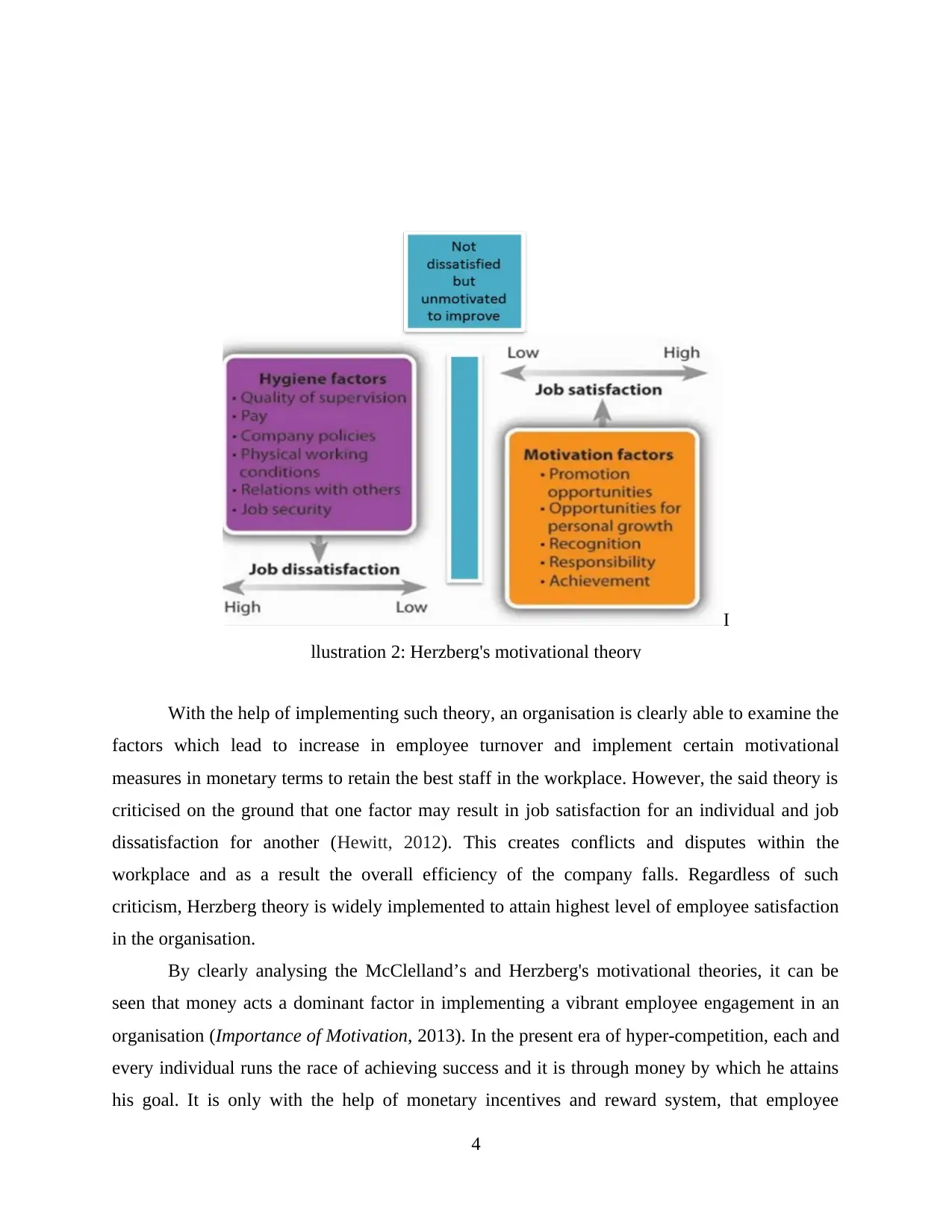
With the help of implementing such theory, an organisation is clearly able to examine the
factors which lead to increase in employee turnover and implement certain motivational
measures in monetary terms to retain the best staff in the workplace. However, the said theory is
criticised on the ground that one factor may result in job satisfaction for an individual and job
dissatisfaction for another (Hewitt, 2012). This creates conflicts and disputes within the
workplace and as a result the overall efficiency of the company falls. Regardless of such
criticism, Herzberg theory is widely implemented to attain highest level of employee satisfaction
in the organisation.
By clearly analysing the McClelland’s and Herzberg's motivational theories, it can be
seen that money acts a dominant factor in implementing a vibrant employee engagement in an
organisation (Importance of Motivation, 2013). In the present era of hyper-competition, each and
every individual runs the race of achieving success and it is through money by which he attains
his goal. It is only with the help of monetary incentives and reward system, that employee
4
I
llustration 2: Herzberg's motivational theory
factors which lead to increase in employee turnover and implement certain motivational
measures in monetary terms to retain the best staff in the workplace. However, the said theory is
criticised on the ground that one factor may result in job satisfaction for an individual and job
dissatisfaction for another (Hewitt, 2012). This creates conflicts and disputes within the
workplace and as a result the overall efficiency of the company falls. Regardless of such
criticism, Herzberg theory is widely implemented to attain highest level of employee satisfaction
in the organisation.
By clearly analysing the McClelland’s and Herzberg's motivational theories, it can be
seen that money acts a dominant factor in implementing a vibrant employee engagement in an
organisation (Importance of Motivation, 2013). In the present era of hyper-competition, each and
every individual runs the race of achieving success and it is through money by which he attains
his goal. It is only with the help of monetary incentives and reward system, that employee
4
I
llustration 2: Herzberg's motivational theory
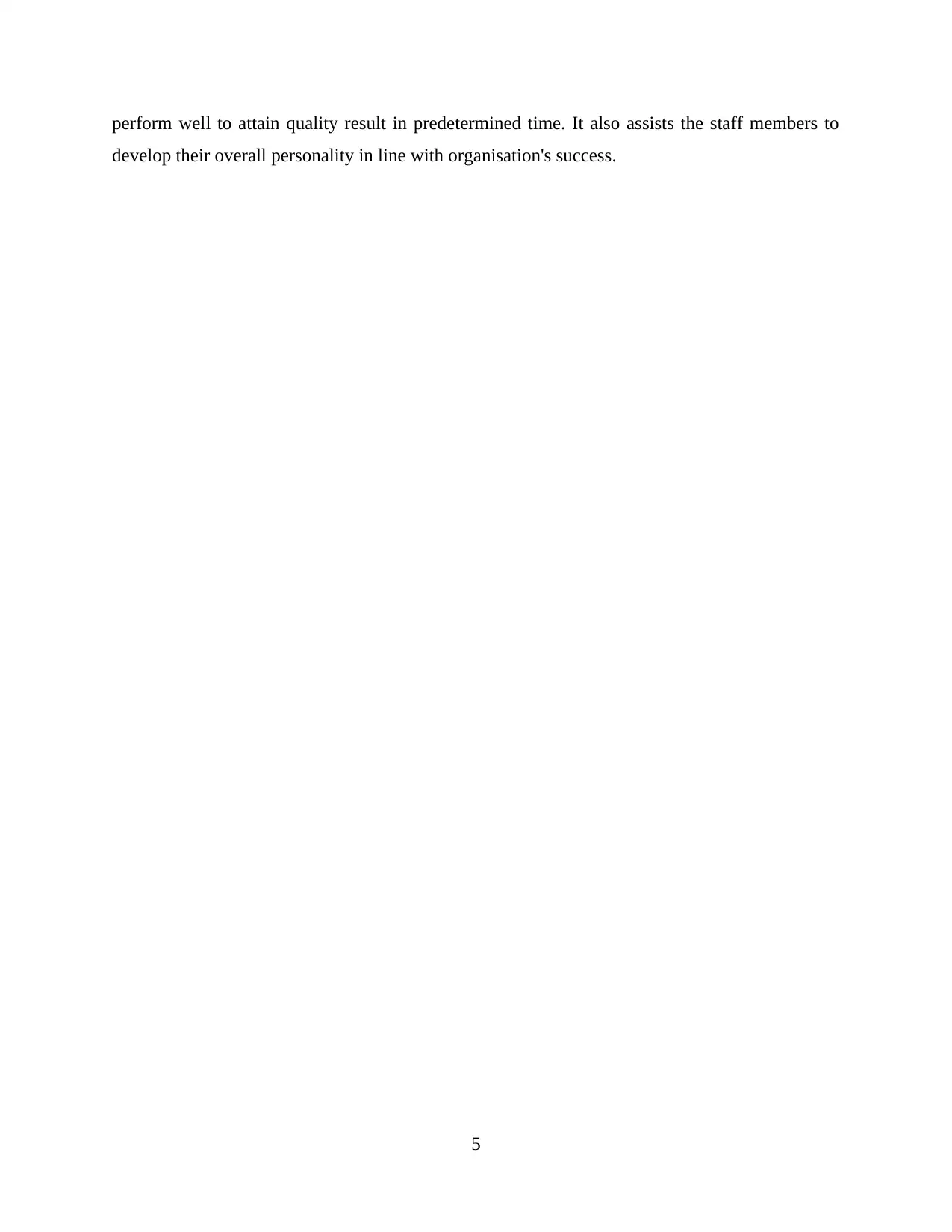
perform well to attain quality result in predetermined time. It also assists the staff members to
develop their overall personality in line with organisation's success.
5
develop their overall personality in line with organisation's success.
5
⊘ This is a preview!⊘
Do you want full access?
Subscribe today to unlock all pages.

Trusted by 1+ million students worldwide
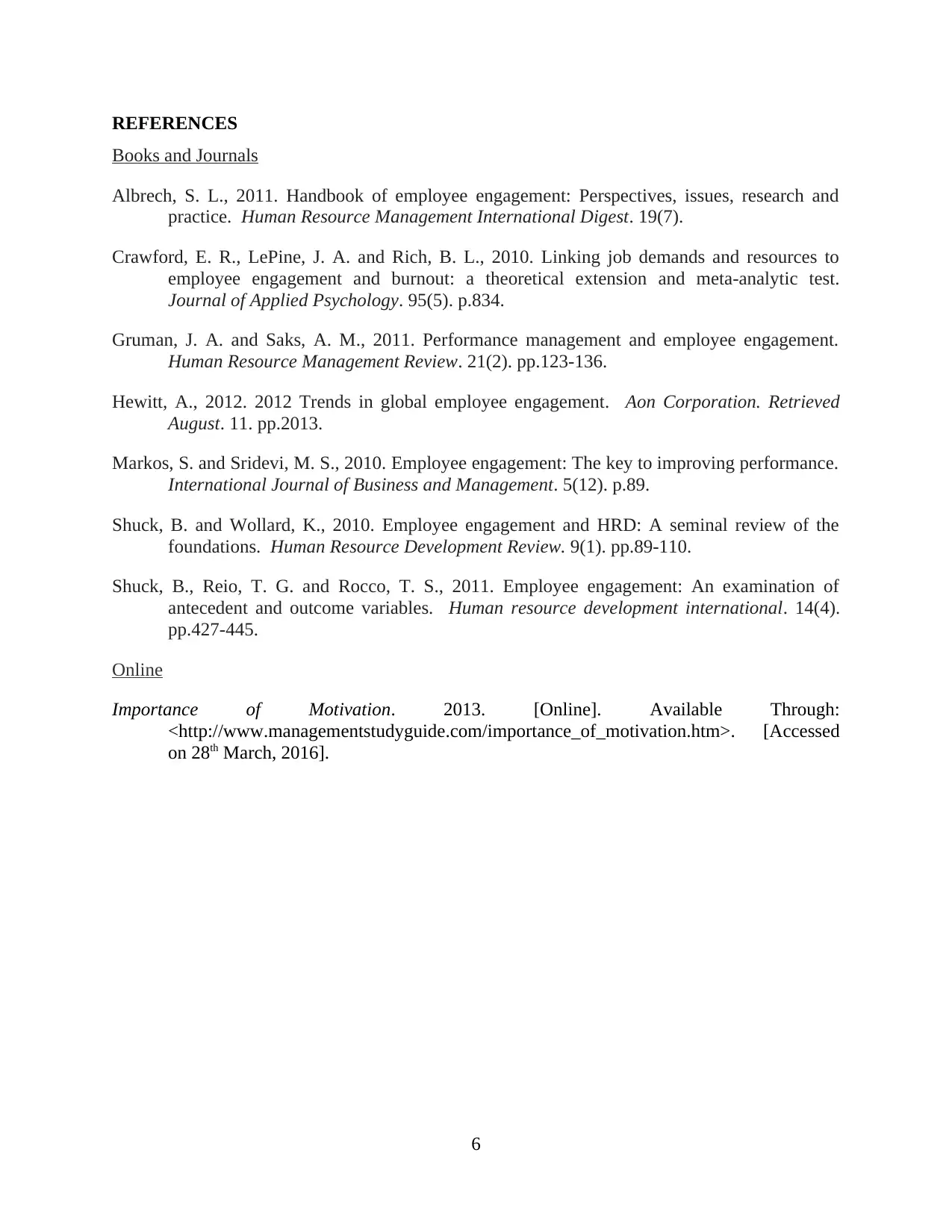
REFERENCES
Books and Journals
Albrech, S. L., 2011. Handbook of employee engagement: Perspectives, issues, research and
practice. Human Resource Management International Digest. 19(7).
Crawford, E. R., LePine, J. A. and Rich, B. L., 2010. Linking job demands and resources to
employee engagement and burnout: a theoretical extension and meta-analytic test.
Journal of Applied Psychology. 95(5). p.834.
Gruman, J. A. and Saks, A. M., 2011. Performance management and employee engagement.
Human Resource Management Review. 21(2). pp.123-136.
Hewitt, A., 2012. 2012 Trends in global employee engagement. Aon Corporation. Retrieved
August. 11. pp.2013.
Markos, S. and Sridevi, M. S., 2010. Employee engagement: The key to improving performance.
International Journal of Business and Management. 5(12). p.89.
Shuck, B. and Wollard, K., 2010. Employee engagement and HRD: A seminal review of the
foundations. Human Resource Development Review. 9(1). pp.89-110.
Shuck, B., Reio, T. G. and Rocco, T. S., 2011. Employee engagement: An examination of
antecedent and outcome variables. Human resource development international. 14(4).
pp.427-445.
Online
Importance of Motivation. 2013. [Online]. Available Through:
<http://www.managementstudyguide.com/importance_of_motivation.htm>. [Accessed
on 28th March, 2016].
6
Books and Journals
Albrech, S. L., 2011. Handbook of employee engagement: Perspectives, issues, research and
practice. Human Resource Management International Digest. 19(7).
Crawford, E. R., LePine, J. A. and Rich, B. L., 2010. Linking job demands and resources to
employee engagement and burnout: a theoretical extension and meta-analytic test.
Journal of Applied Psychology. 95(5). p.834.
Gruman, J. A. and Saks, A. M., 2011. Performance management and employee engagement.
Human Resource Management Review. 21(2). pp.123-136.
Hewitt, A., 2012. 2012 Trends in global employee engagement. Aon Corporation. Retrieved
August. 11. pp.2013.
Markos, S. and Sridevi, M. S., 2010. Employee engagement: The key to improving performance.
International Journal of Business and Management. 5(12). p.89.
Shuck, B. and Wollard, K., 2010. Employee engagement and HRD: A seminal review of the
foundations. Human Resource Development Review. 9(1). pp.89-110.
Shuck, B., Reio, T. G. and Rocco, T. S., 2011. Employee engagement: An examination of
antecedent and outcome variables. Human resource development international. 14(4).
pp.427-445.
Online
Importance of Motivation. 2013. [Online]. Available Through:
<http://www.managementstudyguide.com/importance_of_motivation.htm>. [Accessed
on 28th March, 2016].
6
1 out of 7
Related Documents
Your All-in-One AI-Powered Toolkit for Academic Success.
+13062052269
info@desklib.com
Available 24*7 on WhatsApp / Email
![[object Object]](/_next/static/media/star-bottom.7253800d.svg)
Unlock your academic potential
Copyright © 2020–2025 A2Z Services. All Rights Reserved. Developed and managed by ZUCOL.





